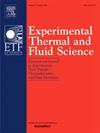GDI喷淋壁对加热和仪表化壁的冲击
IF 2.8
2区 工程技术
Q2 ENGINEERING, MECHANICAL
Experimental Thermal and Fluid Science
Pub Date : 2025-03-19
DOI:10.1016/j.expthermflusci.2025.111475
引用次数: 0
摘要
喷壁相互作用(SWI)对燃料的雾化、混合和燃烧行为以及污染物排放的形成至关重要。这些难以捉摸的影响影响内燃机性能和其他工程应用,如喷雾诱导冷却、喷漆和固体沉积控制。因此,喷雾壁相互作用是一个活跃的研究领域。本文旨在利用温控钢壁研究喷墙相互作用现象。采用了Continental公司生产的多孔喷油器。采用异辛烷作为喷射燃料,将壁面置于距喷油器尖端一段距离和一个倾角的位置,从而改变壁面温度、喷射压力、环境背压、环境温度和燃油温度。分析了喷淋壁面传热过程,采用高速热电偶安装在壁面上,利用一维瞬态壁面热模型测量了喷淋壁面的热流密度。环境温度和壁温对喷雾中的液体量有很大影响。通过提高两种温度,发现了较少的液体。对于在实验活动中评估的范围,结果显示表面热流和壁面温度随壁面和燃料温度以及环境温度的变化而显著增加,但程度较小。本文章由计算机程序翻译,如有差异,请以英文原文为准。
GDI spray wall impingement against a heated and instrumented wall
Spray–wall interaction (SWI) is critical in the atomization, mixing, and combustion behavior of fuels and the formation of pollutant emissions. These elusive effects impact internal combustion engine performance and other engineering applications such as spray-induced cooling, painting, and solid deposit control. As a result, spray wall interactions are an active area of research. This article aims to use a thermoregulated steel wall to study the spray–wall interaction phenomenon. A multi-hole injector manufactured by Continental was used. Isooctane was employed as the injected fuel, and the wall was positioned at one distance from the injector tip and one inclination angle, changing the wall surface temperature, the injection pressure, the ambient back pressure, the ambient temperature, and the fuel temperature. The spray–wall heat transfer is analyzed, and the heat flux is measured by employing high-speed thermocouples fitted in the wall and using a one-dimensional transient wall heat model. The ambient and wall temperatures highly affect the amount of liquid in the spray. By increasing both temperatures, a lesser amount of liquid was found. For the range evaluated in the experimental campaign, the results revealed a significant increase in surface heat flow and wall temperature variance with both wall and fuel temperatures and the ambient temperature, but to a lesser extent.
求助全文
通过发布文献求助,成功后即可免费获取论文全文。
去求助
来源期刊

Experimental Thermal and Fluid Science
工程技术-工程:机械
CiteScore
6.70
自引率
3.10%
发文量
159
审稿时长
34 days
期刊介绍:
Experimental Thermal and Fluid Science provides a forum for research emphasizing experimental work that enhances fundamental understanding of heat transfer, thermodynamics, and fluid mechanics. In addition to the principal areas of research, the journal covers research results in related fields, including combined heat and mass transfer, flows with phase transition, micro- and nano-scale systems, multiphase flow, combustion, radiative transfer, porous media, cryogenics, turbulence, and novel experimental techniques.
 求助内容:
求助内容: 应助结果提醒方式:
应助结果提醒方式:


